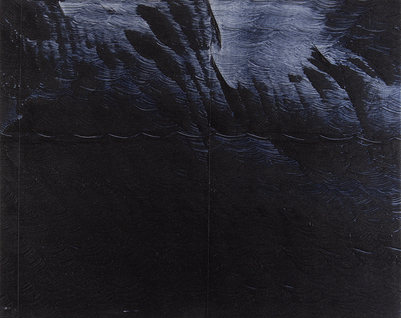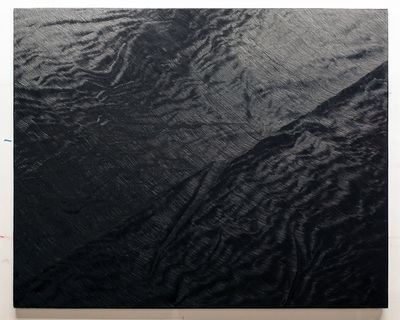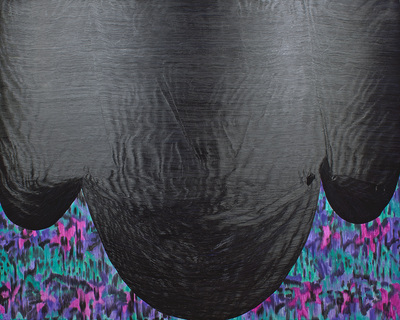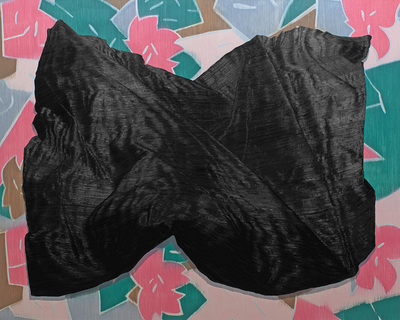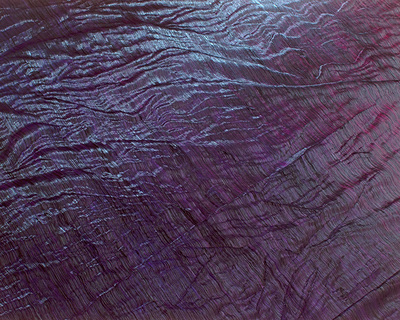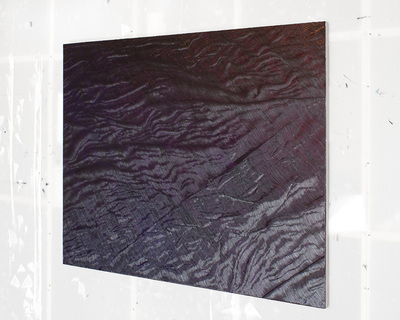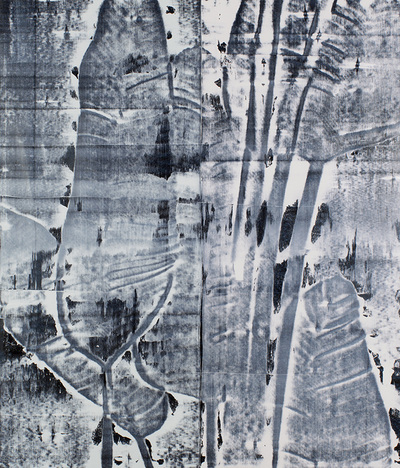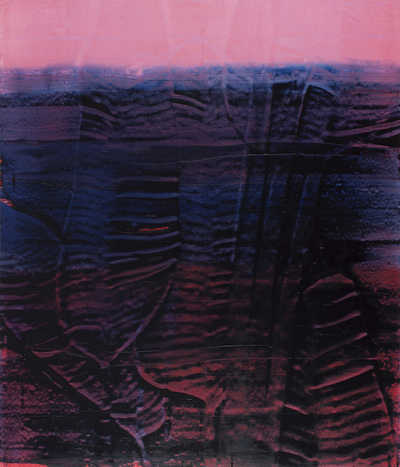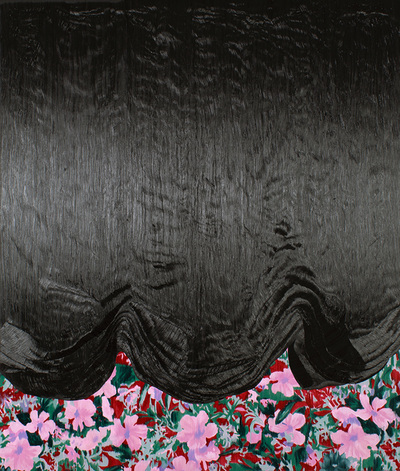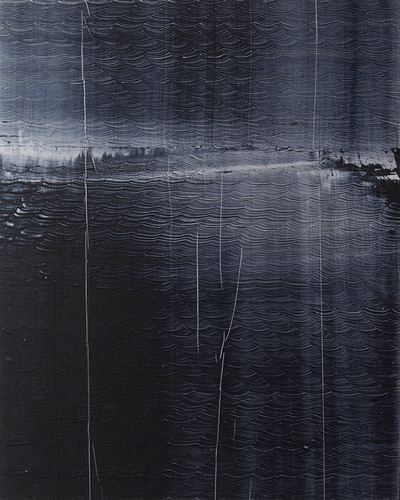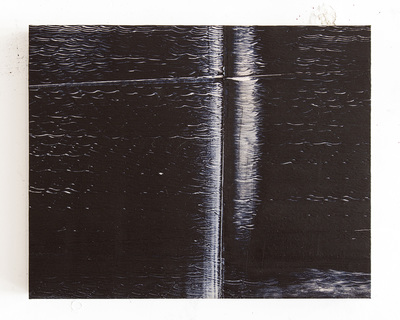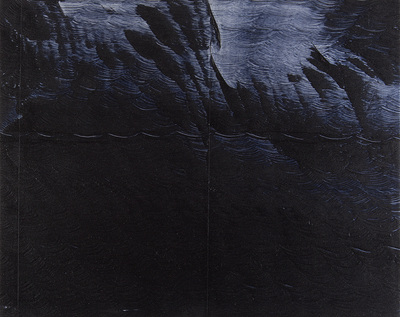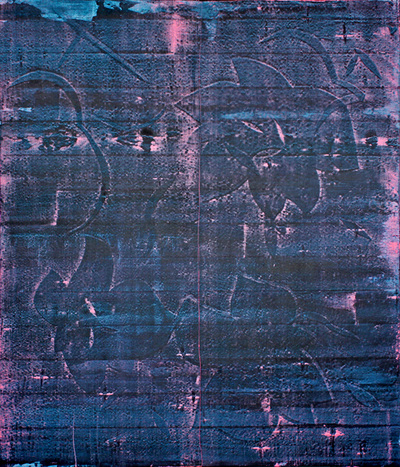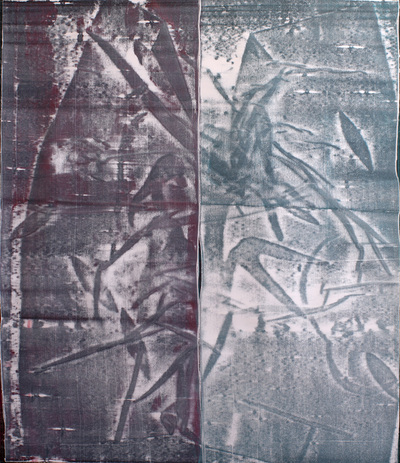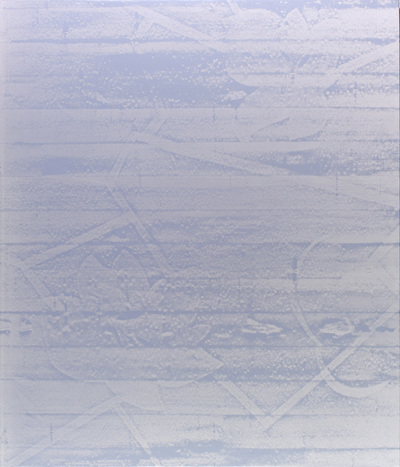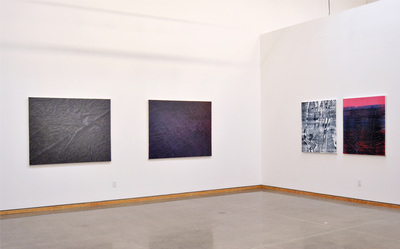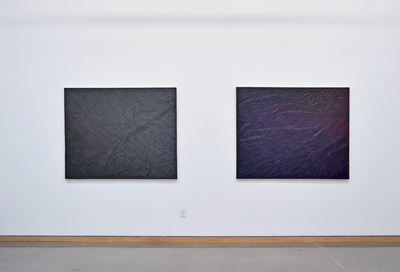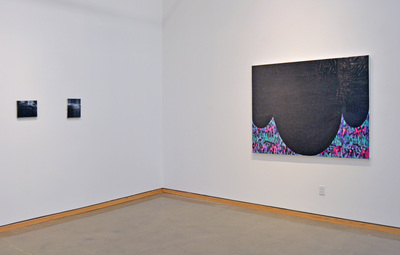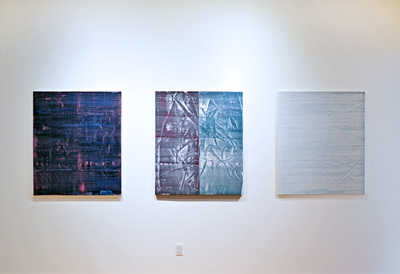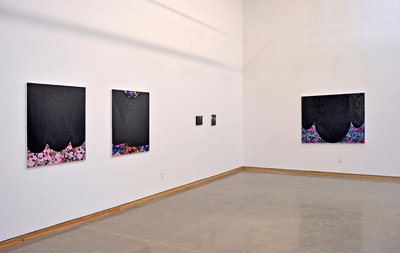While a glancing impression of the artist’s deceptively austere and minimalist canvases may lead one to see Hutchinson’s work in the lineage of Malevich who inaugurated the black monochrome as a sign of painting’s endgame in 1915 (two years before Marcel Duchamp exhibited his equally apocalyptic Urinal in 1917) or the black monochromes of Ad Reinhardt or black on black paintings of Pierre Soulages, Hutchinson’s paintings are monochromes only semantically. Certainly, the artist often uses low tonal value dark paint (an assumption this show will challenge), but his pictures are rather teeming with pictorial incidence and delicate, refined brushwork. And while Hutchinson prizes the compositional aesthetic of the allover, his pictures are resolutely pictorial and sensual, instead of calculatedly non-objective. But like Soulages and Reinhardt, Hutchinson’s pictures promote and reward long durations of immersive looking as they dramatize the gaze of the viewer. And what he also shares with the most advanced modernist painters is an impulse to reduce his parameters of expression in the hopes of plumbing and mining them for their full creative potential.
His fourth solo-exhibition at Angell Gallery promises even those familiar with Hutchinson’s corpus several surprises. First, the artist moves even further away from the figurative and towards full-blown abstraction, facing head on the problem of ornament and the decorative. Second, while the motif of the dark monochrome persists, Hutchinson introduces vibrant colours and floral motifs drawn from local textile stores and visits to the nearby tropical greenhouse. One work the artist showed me was produced through a technique similar to Surrealist grattage where the artist picked up patterns from the wood panel floorboards of his studio space.
Over the past several years, Hutchinson has a developed a sort of indexical regionalism in his work. The first breakthrough came when the artist was serving a residency in a seaside town in Sweden where he began to explore the dynamics of place and geography. With nothing but the roaring weather engulfing his cabin-cum-studio Hutchinson capitulated and introduced the motif of the weather and ocean into his work. Perhaps not since Courbet’s seasides have bodies of water been committed to canvas with such painterly conviction and single-mindedness of purpose. Hutchinson erases any orienting sense of horizon or landscape so that the viewer is engulfed by an oceanic sense of rhythm and pictorial dedifferentiation.
The aesthetics of the topsy turvy and the oceanic appear again in the upcoming show into two large black paintings called respectively Fold and Mirror, Mirror but also in the series of paintings entitled 16 Days at Sea. These are not representational or mimetic works by any means. Rather it seems that through a kind of pictorial automatism Hutchinson has captured the rhythm of vast expanses of water. The brushtrokes map contours of idealised and observed forms while also taking cues from the rhythms and perturbations of each preceding stroke, one after the other, top to bottom of the picture plane (or ‘picture-as table’) until a field of marks maps out the smooth flatness of the support and its own self-generating morphology. Certainly the motif of waves are present if we want to see them but there is a larger feeling of undulation that serves as a kind of palliative balm for overstimulated and overstressed contemporary eyes.
In the upcoming show Hutchinson also playfully uses painting to absorb and cite other media. By superimposing different indexical registers in some paintings Hutchinson creates an “off-register” effect that suggests Xerox photocopying, the scansion lines of the televisual or digital monitors, and while none of this is by any means overt, the effect persists as a sort of ghostly superimposition in paintings such as the ephemeral After the Clouds Passed (impressions on your eyes). This “intermedial” effect is also suggestive elsewhere in the rich luxury of satiny textiles that obliterate and opacy our vision or screen our eyes. In the impressively dramatic It Could Be You. It Could Be Me., the artist stages the battle between the abstract and the decorative where the black monochrome is encroached upon by floral ornamentation.
While Hutchinson’s exhibition shows the artist embracing neoavantgarde strategies as never before there is nothing “anti-aesthetic” about these works and it is a testament to how through such a reduction of means and elements Hutchinson is able to achieve complex pictorial effects of rich density and vigor.
Text by Meraj Dhir
Full length essay here: The Painter's Painter
His fourth solo-exhibition at Angell Gallery promises even those familiar with Hutchinson’s corpus several surprises. First, the artist moves even further away from the figurative and towards full-blown abstraction, facing head on the problem of ornament and the decorative. Second, while the motif of the dark monochrome persists, Hutchinson introduces vibrant colours and floral motifs drawn from local textile stores and visits to the nearby tropical greenhouse. One work the artist showed me was produced through a technique similar to Surrealist grattage where the artist picked up patterns from the wood panel floorboards of his studio space.
Over the past several years, Hutchinson has a developed a sort of indexical regionalism in his work. The first breakthrough came when the artist was serving a residency in a seaside town in Sweden where he began to explore the dynamics of place and geography. With nothing but the roaring weather engulfing his cabin-cum-studio Hutchinson capitulated and introduced the motif of the weather and ocean into his work. Perhaps not since Courbet’s seasides have bodies of water been committed to canvas with such painterly conviction and single-mindedness of purpose. Hutchinson erases any orienting sense of horizon or landscape so that the viewer is engulfed by an oceanic sense of rhythm and pictorial dedifferentiation.
The aesthetics of the topsy turvy and the oceanic appear again in the upcoming show into two large black paintings called respectively Fold and Mirror, Mirror but also in the series of paintings entitled 16 Days at Sea. These are not representational or mimetic works by any means. Rather it seems that through a kind of pictorial automatism Hutchinson has captured the rhythm of vast expanses of water. The brushtrokes map contours of idealised and observed forms while also taking cues from the rhythms and perturbations of each preceding stroke, one after the other, top to bottom of the picture plane (or ‘picture-as table’) until a field of marks maps out the smooth flatness of the support and its own self-generating morphology. Certainly the motif of waves are present if we want to see them but there is a larger feeling of undulation that serves as a kind of palliative balm for overstimulated and overstressed contemporary eyes.
In the upcoming show Hutchinson also playfully uses painting to absorb and cite other media. By superimposing different indexical registers in some paintings Hutchinson creates an “off-register” effect that suggests Xerox photocopying, the scansion lines of the televisual or digital monitors, and while none of this is by any means overt, the effect persists as a sort of ghostly superimposition in paintings such as the ephemeral After the Clouds Passed (impressions on your eyes). This “intermedial” effect is also suggestive elsewhere in the rich luxury of satiny textiles that obliterate and opacy our vision or screen our eyes. In the impressively dramatic It Could Be You. It Could Be Me., the artist stages the battle between the abstract and the decorative where the black monochrome is encroached upon by floral ornamentation.
While Hutchinson’s exhibition shows the artist embracing neoavantgarde strategies as never before there is nothing “anti-aesthetic” about these works and it is a testament to how through such a reduction of means and elements Hutchinson is able to achieve complex pictorial effects of rich density and vigor.
Text by Meraj Dhir
Full length essay here: The Painter's Painter
